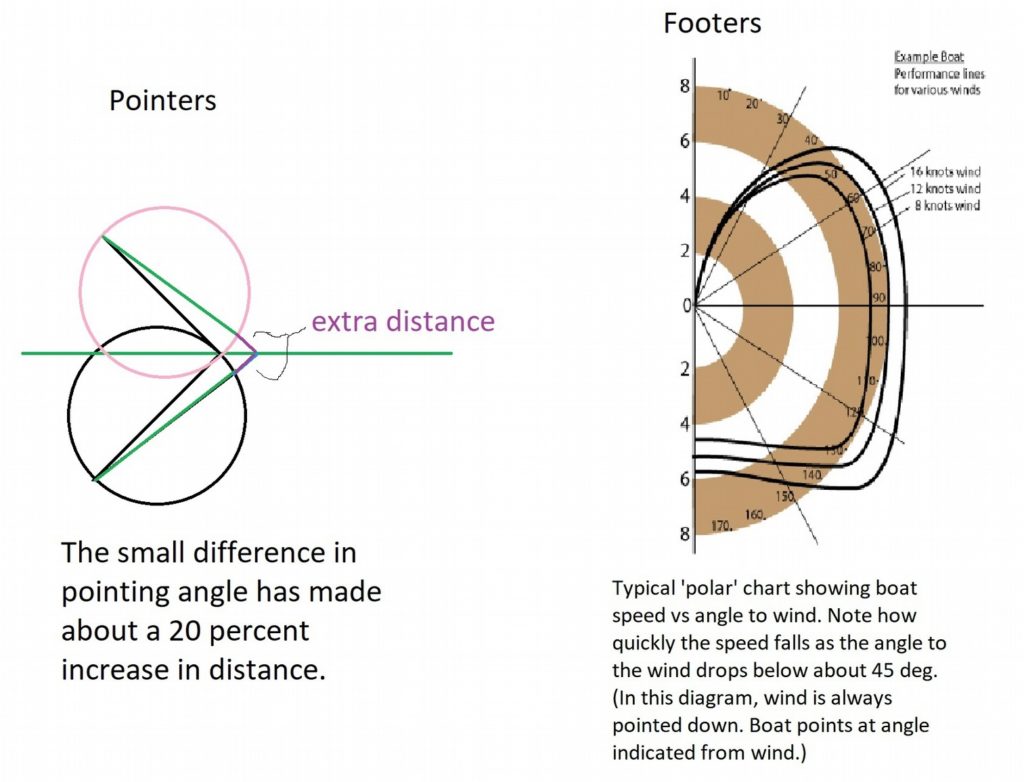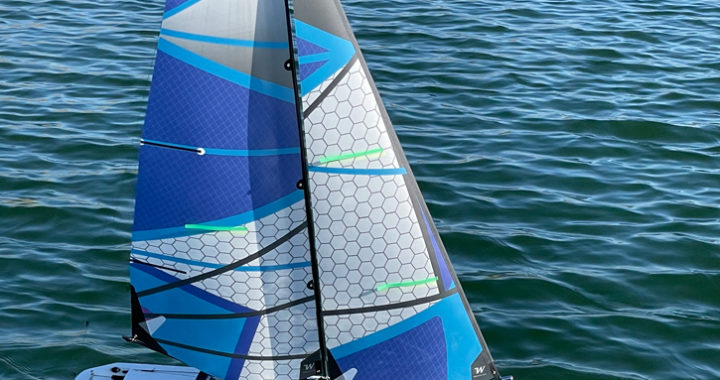
Pointers and Footers
There are two types of sailors, Pointers and Footers. I am a Pointer. Russ Gardner and, I think, Chris Macaluso (many-time Victoria National Champion) are Footers. So what are Pointers and Footers?
Simply put, Pointers place a little extra emphasis on pointing close to the wind, in order to decrease the distance sailed to upwind marks, while Footers emphasize boat speed in order to get there quicker. Note, though, that the actual differences in pointing angles between Pointers and Footers are very small, perhaps as small as 1 degree, because Footers can't afford to give up too much distance, while Pointers can't afford to go slow because of pointing too much into the wind..

Figure 1: Pointers versus Footers
In the Pointer side of Figure 1, the circles show that on each leg of a two-leg upwind sail, a fairly small difference in angle to the wind can add 15 to 20 percent to the distance. (I did not measure the angles when I drew this diagram. Looks to me like the angles are about 10 degrees. Could use trigonometry to calculate the extra distance exactly. A rough estimate from the above drawing is that each degree adds 1 to 2 percent to the distance traveled.)
The Footer chart shows a typical 'Polar' diagram, which shows a particular boat's speed
at three different wind velocities, according to how the boat points relative to the wind. In this chart, the wind is always blowing straight down, and the boat is pointing at the angle indicated by the protractor on the right side. Note that trying to point just a little closer to the wind than 45 degrees, for this boat, causes a large decrease in boat speed. (The speed is shown by the distance from the center to the dark lines according to wind velocity.) Pointing a little higher than 45 degrees for this boat would be 'pinching,' a last-ditch effort to avoid tacking by sailing a little too high and going slow. Our rc sailboats typically can point effectively at about 45 degrees to the wind. That is why, when we tack, we typically have to point at what had been straight to the side.
So we see that Pointers and Footers both have to point at about the same angle to the wind to go upwind, because to do otherwise means a loss. Pointers watch closely to sail as close to the wind as they can go without losing speed, while Footers try to go faster without heading so far off that the extra distance kills them.
In other words, there really isn't much difference between the two types.
Berry Pond is a special situation... All ponds get wind shifts, because all ponds lie at least a little below ground level (or the water would all run out), and most have trees or houses to cause additional disturbances. But Berry Pond is the trickiest I've seen, by far. (Probably because it is not only below ground level with trees around, but is also in a shallow valley.)
If a wind shift is a 'header,' that is, a shift of the wind more directly over the bow of the boat, the sails flutter and the boat slows, and the difference is dramatic enough not to be missed. But a 'lift,' where the boat might effectively point 15 to even 45 degrees higher is also common, and unless the wind is strong enough to make the boat heel, the signs are not quite so easy to read. In fact, the signs might be missed altogether, until the skipper tacks and discovers he has to tack through a whole lot more than 90 degrees to fill the sails again. That is, he has not taken advantage of the lift to point more directly to the mark, so has not closed the distance to the mark nearly so much as he might have.
One help in detecting favorable wind shifts is weather helm. With weather helm, if the skipper allows the boat to probe higher into the wind, he can detect the helpful shift and take advantage of it. However, as the frequent wind shifts on Berry Pond make weather helm especially useful to help discover a favorable shift, they also mean the skipper must react more quickly to a header, an unfavorable shift. 'Going into irons,' pointing into the wind long enough to lose boat speed and thereby lose the rudder's effectiveness, is a little more likely when the boat is continually probing upwind, and furthermore, weather helm wants to keep the bow pointing into the wind, making it more difficult to get out of irons. (So if you have a lot of trouble going into irons, and trouble getting out of irons, try moving the rig forward to decrease weather helm. Just don't go too far and
end up with leeward helm.)
A clear case of skipper's choice...
{In case the use of the polar diagram wasn't clear, let me add some explanation. Say you want to know what speed a boat will make in a 12 knot wind (about 13 mph), if the boat sails at 60 degrees off the wind. Draw a line from the center of the diagram at a 60 degree angle from straight up, look at where that line crosses the polar curve for a 12 kt wind, and the length of that line from the center to that crossing point represents the speed the boat will make. There are circles around the center that represent boat speed, shown as alternating bands of tan and white, so the boat speed may be read directly, without the trouble of using a ruler to measure the distance from the center to the polar curve. This boat's max speed is a little over 8 kts. You may also note that this boat is fastest when the wind is off the stern quarter – which is typical of big boats – and may go enough faster off the wind to justify jibing left and right rather than just running straight downwind. This is seldom the case with our rc sailboats.}
Author: Mike Biggs
